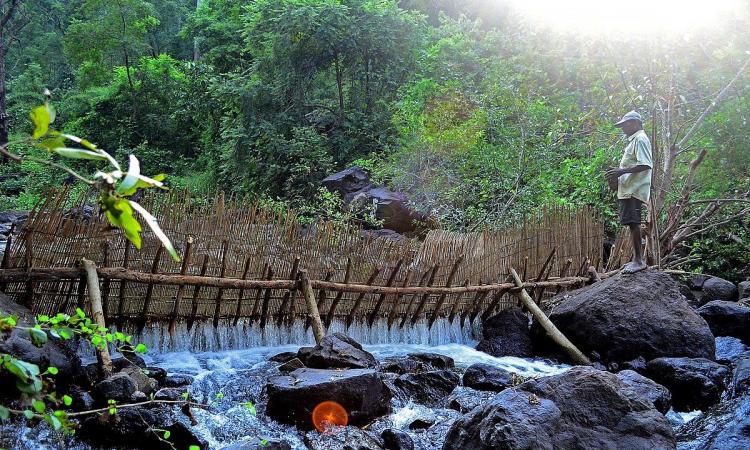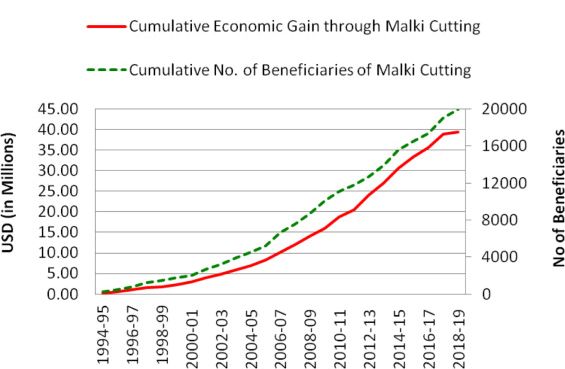
Considering the global trend of alarming deforestation, it is very important to study various forest management strategies to understand their effectiveness and limitations. It is important to conserve the forests, but the economic sustainability of the people directly linked with the forests cannot be ignored.
Due to very limited availability of the socio-economic data of the people directly dependent on forests (especially in the developing countries) and the lack of an inter-disciplinary approach interfacing the socio-economic data with the scientifically estimated forest area and its green cover density, not many studies could comprehensively bring out the effectiveness of a particular forest management approach.
A recent paper by Dasa et al in Trees, Forests and People presents a study that connects these two independent datasets and underlines the usefulness of the ‘Malki practice’ driven forest management approach in the Dang forests of Gujarat. The Dang district, situated in the Sahyadri foothills is a highly hilly region mostly dominated by the tribal population. It has the highest forest density in the state. The main occupation of the locals here is agriculture or forest-based.
The word ‘Malki’ means ‘ownership’ and in 1984, the Government of Gujarat introduced the practice wherein the landholders were permitted to cut the trees for economic gains provided they had initiated the plantation of the requisite number of trees against the trees to be cut. The provisions contained in the practice gradually evolved during the 25 years (1984-2009).
The study uses the remotely sensed Normalized Difference Vegetation Index (NDVI) to estimate the green cover density in the Dang forests, a statistical approach for assessing the type of trend in the NDVI (increasing or decreasing at different significance levels) and the socio-economic data generated by the State Forest Department regarding the earnings made through the sale of logs and the household surveys.
The environmental success of the Malki practice can be seen from the fact that 74% of the Dang forests witnessed an increasing trend in the green cover density which backs the fact that around one million trees would have been planted in the forest in-lieu of the 200,000 trees which were cut during 1994–2019. Also, the economic success of the Malki practice can be attributed to the fact that 19,936 land holders earned 39.4 million US $ through the sale of logs.
Suggestive framework for strengthening the Malki practice for forest conservation
- Use of satellite data and (or) drone survey for forest mapping: The Forest Department should use high resolution satellite data extensively and also conduct drone survey for mapping the forest cover. This tree cover database should be periodically updated (at least once in a season – winter, summer and monsoon). Efforts should be made to incorporate attributes like tree type, age of the tree, etc.
- Digital database of land holdings: A GIS based digital database of the land belonging to the land holders should be prepared and the database should be regularly updated.
- GPS locations of Malki led tree-plantation and tree-cutting: To bring more transparency and accountability in the Malki led tree-plantation and tree-cutting, the Forest Department should make it mandatory for the land holders to submit the GPS locations of both – the new plantations done and the trees that are proposed to be cut. Both these patches of ‘tree-plantation’ and ‘tree-cutting’ can be digitally earmarked in the GIS platform and should be linked to the specific land holder
- Annual sustainable development map: The Forest Department should have a GIS database of Malki led planting and cutting of trees which should be updated as per the proceedings and an ‘Annual Sustainable Development Map’ should be prepared every year showing respective areas.
- Ranking of the landholders based on the health of their trees: The Forest Department should evolve a framework for ranking the land holders on the basis of the health of the trees which they had planted while availing the permission for the Malki cutting. This ranking should be one of the criteria in deciding the permission for the subsequent Malki cutting. This would incentivize the efforts of the land holders for taking good care of their trees (green cover).
- Incorporation of Social Security Schemes: Around 20–30% of the earnings made through Malki cutting should be deposited in social security schemes like the National Pension Scheme launched by the Central Government so that the land holders can have an old age financial security.
Results and discussion

This economic gain would have definitely improved the quality of life of the beneficiaries and their families. The one-to-one interaction with the 400 beneficiaries of the ‘Malki practice’ revealed that around 81% of them who were earlier economically dependent on others become self-reliant. 59% had the annual income in the range of $260–550, followed by 15, 8 and 3% who annually earned in the range of $550–1000, $1000–1300 and more than $1300 while only 15% had the annual income less than $260.
This is noteworthy because the people annually earning less than $157 come under ‘below poverty line’. 94% of the beneficiaries had a house of their own though only 19% of them had house with proper walls and roof of concrete while the remaining 81% of them had the house built with mud, grass and thatch. These facts clearly indicate that the ‘Malki practice’ indeed improved the socio-economic conditions of the land holders thereby positively impacting their quality of life.
From this study, it can be decisively said that ‘Malki practice’ is a classic case of sustainable development exhibiting that a sound-incentivized policy along with wide public awareness can create wonders.
In addition to this, by incorporating measures like using satellite data and (or) drone survey for forest mapping, creating digital database of land holdings, collecting the GPS locations of Malki led afforestation-deforestation and preparing the annual sustainable development map, ranking of the land holders based on the health of their trees, incorporation of the social security schemes; the effectiveness of the Malki practice for forest conservation can be significantly increased.
Malki practice can be considered as an alternative to, for example, shifting cultivation or Jhum cultivation or Swidden agriculture (a technique of rotational farming in which land is cleared for cultivation normally by fire) and then left to regenerate for few years) which is practiced in some parts of the North East region of India, Bangladesh, Latin America and Central Africa and indigenous people may be encouraged to derive livelihood from the wood based products subject to compensatory afforestation (around 3–5 times).
The present study would be of great help for not only revamping and (or) fine-tuning the forest management strategies being implemented across the world but also for evaluating the effectiveness of a particular forest management strategy.
The full paper can be accessed here